Spring Boot应用的健康监控
在之前的系列文章中我们学习了如何进行Spring Boot应用的功能开发,以及如何写单元测试、集成测试等,然而,在实际的软件开发中需要做的不仅如此:还包括对应用程序的监控和管理。
正如飞行员不喜欢盲目飞行,程序员也需要实时看到自己的应用目前的运行情况。如果给定一个具体的时间,我们希望知道此时CPU的利用率、内存的利用率、数据库连接是否正常以及在给定时间段内有多少客户请求等指标;不仅如此,我们希望通过图表、控制面板来展示上述信息。最重要的是:老板和业务人员希望看到的是图表,这些比较直观易懂。
首先,这篇文章讲介绍如何定制自己的health indicator。
实战
- 在pom文件中添加 spring-boot-starter-actuator 依赖
<dependency> <groupId>org.springframework.boot</groupId> <artifactId>spring-boot-starter-actuator</artifactId> </dependency>
- spring-boot-starter-actuator 这个库让我们可以访问应用的很多信息,包括:/env、/info、/metrics、/health等。现在运行程序,然后在浏览器中访问:http://localhost:8080/health,将可以看到下列内容。
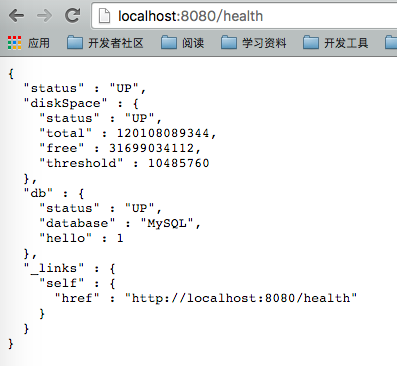
- 除了/health可以访问,其他的Endpoints也可以访问,例如/info:首先在 application.properties 文件中添加对应的属性值,符号 @ 包围的属性值来自pom.xml文件中的元素节点。
info.build.artifact=@project.artifactId@ info.build.name=@project.name@ info.build.description=@project.description@ info.build.version=@project.version@
- 要获取配置文件中的节点值,需要在pom文件中进行一定的配置,首先在
节点里面添加:
<resources>
<resource>
<directory>src/main/resources</directory>
<filtering>true</filtering>
</resource>
</resources>
然后在
<plugin>
<groupId>org.apache.maven.plugins</groupId>
<artifactId>maven-resources-plugin</artifactId>
<version>2.6</version>
<configuration>
<delimiters>
<delimiter>@</delimiter>
</delimiters>
<useDefaultDelimiters>false</useDefaultDelimiters>
</configuration>
</plugin>
- 然后运行应用程序,访问http://localhost:8080/info,可以看到下列信息
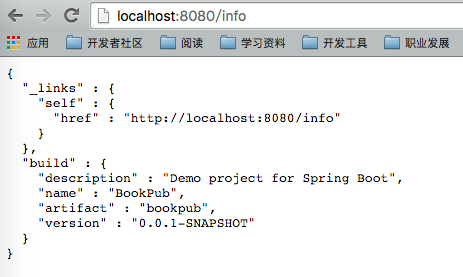
- 除了使用系统默认的监控信息,我们还可以定义自己的health indicator。使用 Spring Boot:定制自己的starter 一文中做过的db-count-starter作为观察对象,我们希望监控每个数据库接口的运行状况:如果某个接口返回的个数大于等于0,则表示系统正常,表示为UP状态;否则,可能该接口发生异常,表示为DOWN状态。首先,将DbCountRunner类中的getRepositoryName方法由private转为protected,然后在db-count-starter这个模块中也添加actuator依赖。
- 在 db-count-starter/src/main/com/test/bookpubstarter 目录下创建 DbCountHealthIndicator.java 文件
public class DbCountHealthIndicator implements HealthIndicator {
private CrudRepository crudRepository;
public DbCountHealthIndicator(CrudRepository crudRepository) {
this.crudRepository = crudRepository;
}
@Override
public Health health() {
try {
long count = crudRepository.count();
if (count >= 0) {
return Health.up().withDetail("count", count).build();
} else {
return Health.unknown().withDetail("count", count).build();
}
} catch (Exception e) {
return Health.down(e).build();
}
}
}
- 最后,还需要注册刚刚创建的健康监控器,在DbCountAutoConfiguration.java中增加如下定义:
@Autowired
private HealthAggregator healthAggregator;
@Bean
public HealthIndicator dbCountHealthIndicator(Collection<CrudRepository> repositories) {
CompositeHealthIndicator compositeHealthIndicator = new
CompositeHealthIndicator(healthAggregator);
for (CrudRepository repository: repositories) {
String name = DbCountRunner.getRepositoryName(repository.getClass());
compositeHealthIndicator.addHealthIndicator(name, new DbCountHealthIndicator(repository));
}
return compositeHealthIndicator;
}
- 运行程序,然后访问http://localhost:8080/health,则可以看到如下结果
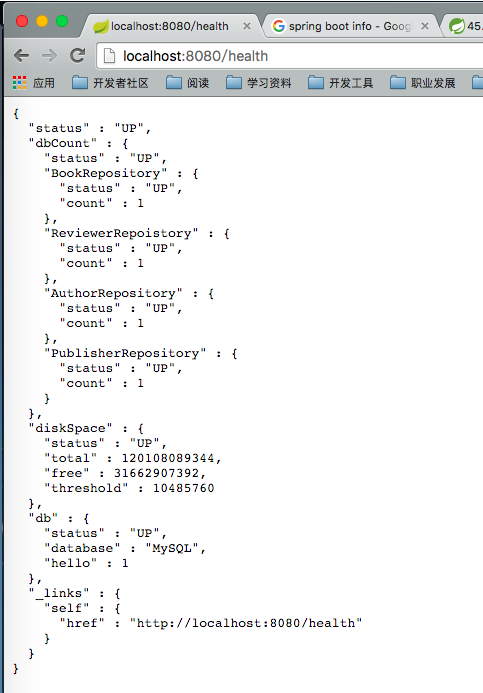
分析
Spring Boot Autuator这个库包括很多自动配置,对外开放了很多endpoints,通过这些endpoints可以访问应用的运行时状态:
- /env 提供应用程序的环境变量,如果你在调试时想知道某个配置项在运行时的值,可以通过这个endpoint访问——访问 http://localhost:8080/env ,可以看到很多方面的配置,例如,class path resources—[tomcat.https.properties]、applicationConfig—[classpath:/application.properties]、commonsConfig、systemEnvironment、systemProperties等。
这些变量的值由 Environment 实例中的 PropertySource 实例保存,根据这些属性值所在的层次,有可能在运行时已经做了值替换,跟配置文件中的不一样了。为了确认某个属性的具体值,例如 book.count.rate 属性,可以访问 http://localhost:8080/env/book.counter.rate 来查询,如果跟配置文件中的不一样,则可能是被系统变量或者命令行参数覆盖了。 EnvironmentEndpoint 类负责实现上述功能,有兴趣可以再看看它的源码; - /configprops 提供不同配置对象,例如 WebConfiguration.TomcatSslConnectionProperties ,它与/env不同的地方在于它会表示出与配置项绑定的对象。尝试下访问 http://localhost:8080/configprops ,然后在网页中查询 custom.tomcat.https ,可以看到我们之前用于配置 TomcatSslConnector 对象的属性值(参见: 让你的Spring Boot工程支持HTTP和HTTPS )。
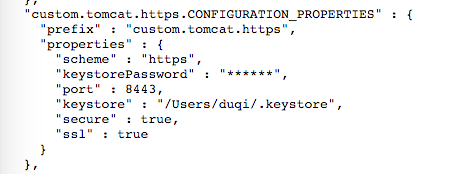
- /autoconfig 以web形式对外暴露AutoConfiguration 信息,这些信息的解释可以参考 Spring Boot:定制自己的starter 一文,这样我们就不需要通过“修改应用程序的日志级别和查看应用的启动信息”来查看应用的自动配置情况了。
- /beans ,这个endpoint列出所有由Spring Boot创建的bean。

- /mapping ,这个endpoint显示当前应用支持的URL映射,该映射关系由 HandlerMapping 类维护,通过这个endpoint可以查询某个URL的路由信息。
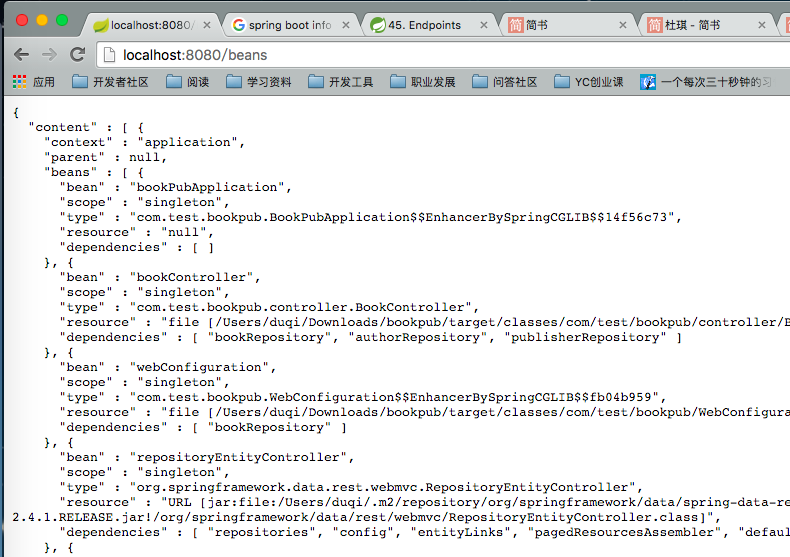
- /info ,这个endpoint显示应用程序的基本描述,在之前的实践例子中我们看过它的返回信息,属性值来自 appliaction.properties ,同时也可以使用占位符获取pom.xml文件中的信息。任何以 info. 开头的属性都会在访问 http://localhost:8080/info 时显示。
- /health 提供应用程序的健康状态,或者是某个核心模块的健康状态。
- /metrics ,这个endpoint显示Metrics 子系统管理的信息,后面的文章会详细介绍它。
上述各个endpoint是Spring Boot Actuator提供的接口和方法,接下来看看我们自己定制的 HealthIndicator ,我们只需要实现 HealthIndicator 接口,Spring Boot会收集该接口的实现,并加入到 /health 这个endpoint中。
在我们的例子中,我们为每个 CrudRepository 实例都创建了一个 HealthIndicator 实例,为此我们创建了一个 CompositeHealthIndicator 实例,由这个实例管理所有的 DbHealthIndicator 实例。作为一个 composite ,它会提供一个内部的层次关系,从而可以返回JSON格式的数据。
代码中的 HealthAggregator 实例的作用是:它维护一个map,告诉 CompositeHealthIndicator 如何决定所有 HealthIndicator 代表的整体的状态。例如,除了一个repository返回DOWN其他的都返回UP,这时候这个composite indicator作为一个整体应该返回UP还是DOWN, HealthAggregator 实例的作用就在这里。
Spring Boot使用的默认的 HealthAggregator 实现是 OrderedHealthAggregator ,它的策略是手机所有的内部状态,然后选出在DOWN、OUT_OF_SERVICE、UP和UNKNOWN中间具有最低优先级的那个状态。这里使用策略设计模式,因此具体的状态判定策略可以改变和定制,例如我们可以创建定制的 HealthAggregator :
最后需要考虑下安全问题,通过这些endpoints暴露出很多应用的信息,当然,Spring Boot也提供了配置项,可以关闭指定的endpoint——在application.properties中配置
还可以通过设置 management.port=-1 关闭endpoint的HTTP访问接口,或者是设置其他的端口,供内部的admin服务访问;除了控制端口,还可以设置仅仅让本地访问,只需要设置 management.address=127.0.0.1 ;通过设置 management.context-path=/admin ,可以设置指定的根路径。综合下,经过上述设置,在本地访问 http://127.0.0.1/admin/health 来访问健康状态。
可以在防火墙上屏蔽掉不是/admin/*的endpoints访问请求,更进一步,利用Spring Security可以配置验证信息,这样要访问当前应用的endpoints必须使用用户名和密码登陆。
参考资料
- Endpoints
- Complete Guide for Spring Boot Actuator
Spring Boot 1.x系列
- Spring Boot的自动配置、Command-line-Runner
- 了解Spring Boot的自动配置
- Spring Boot的@PropertySource注解在整合Redis中的使用
- Spring Boot项目中如何定制HTTP消息转换器
- Spring Boot整合Mongodb提供Restful接口
- Spring中bean的scope
- Spring Boot项目中使用事件派发器模式
- Spring Boot提供RESTful接口时的错误处理实践
- Spring Boot实战之定制自己的starter
- Spring Boot项目如何同时支持HTTP和HTTPS协议
- 自定义的Spring Boot starter如何设置自动配置注解
- Spring Boot项目中使用Mockito
- 在Spring Boot项目中使用Spock测试框架
- Spring Boot项目中如何定制拦截器
- Spring Boot项目中如何定制PropertyEditors
- Spring Boot构建的Web项目如何在服务端校验表单输入
本号专注于后端技术、JVM问题排查和优化、Java面试题、个人成长和自我管理等主题,为读者提供一线开发者的工作和成长经验,期待你能在这里有所收获。

- 本文标签: tomcat 参数 Action map Spring Boot java RESTful 端口 json tar src IO 调试 JVM 协议 CTO REST Property 安全 id spring 管理 源码 实例 js build plugin 开发者 mongo ssl 设计模式 pom 软件 cat Security 服务端 目录 IDE classpath MongoDB https Connection bean UI 专注 web 时间 maven 插件 数据库 文章 希望 redis 测试 程序员 ip 开发 Service 配置 Spring Security apache 代码 db XML description http Collection 数据 单元测试 定制 App
- 版权声明: 本文为互联网转载文章,出处已在文章中说明(部分除外)。如果侵权,请联系本站长删除,谢谢。
- 本文海报: 生成海报一 生成海报二











![[HBLOG]公众号](https://www.liuhaihua.cn/img/qrcode_gzh.jpg)

